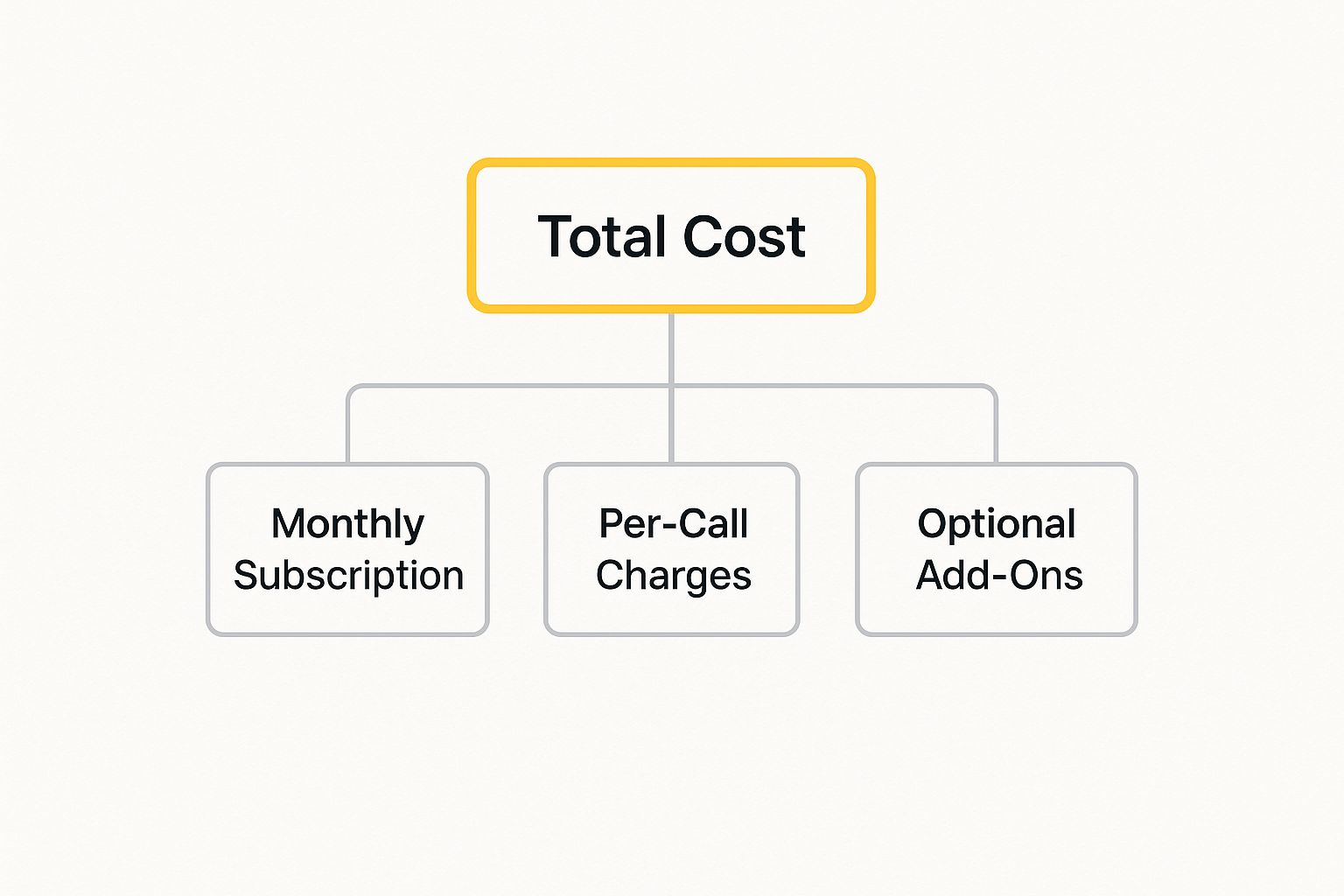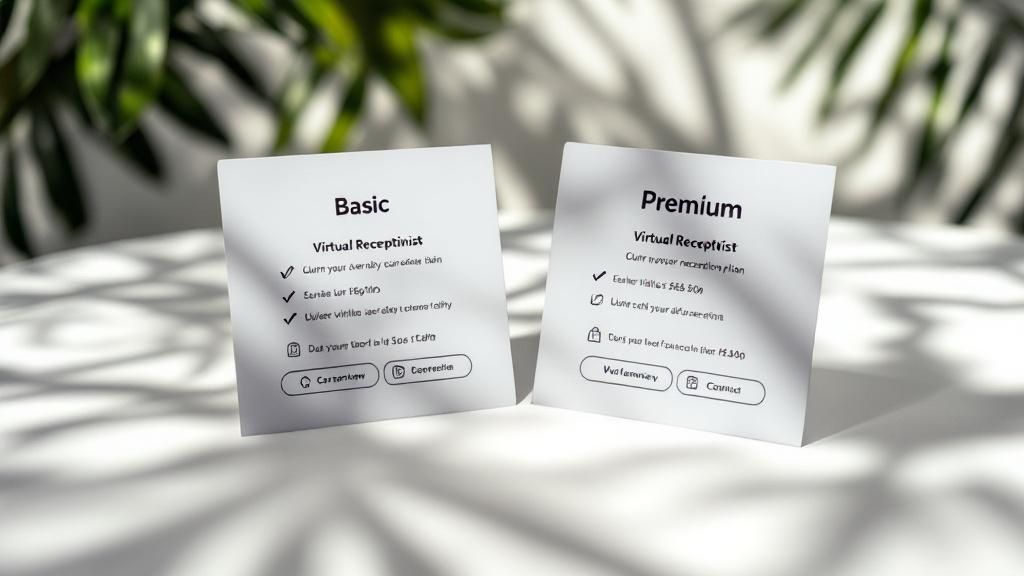Decoding Virtual Receptionist Pricing Like a Pro

Think of this infographic as your cheat sheet for understanding virtual receptionist costs. It neatly breaks down the total cost into three main buckets: monthly subscriptions, per-call charges, and optional add-ons. Seeing these pieces laid out visually helps you understand how the final price tag is built – and reminds you that the initial advertised price is often just the tip of the iceberg.
Knowing what goes into the overall cost is key to budgeting accurately.
Let's take a closer look at each cost factor. Monthly subscriptions are usually your base cost, similar to your internet bill. Just like a faster internet connection with more data costs more, virtual receptionist plans with features like 24/7 availability or advanced call handling usually come with a higher monthly fee.
Per-call charges are important to understand so you avoid any surprises on your invoice. Some plans include a set number of minutes or calls in the monthly fee, while others charge you for each call. This is especially important if your business has a lot of calls one month and fewer the next.
Finally, optional add-ons can also add to the total cost. These could be things like bilingual support or integration with other software like CRM software. Think carefully about which add-ons you actually need. If your business mainly operates within Australia, bilingual support might be an unnecessary extra.
Navigating Virtual Receptionist Pricing in Australia
Navigating these different pricing structures can be a bit tricky, especially with so many options out there. As of May 2025, Australian businesses were paying anywhere from $30 to $600 per month for virtual receptionist services. Some premium providers even charge up to $2,400 a month for more advanced features and high call volumes. You can find out more about virtual receptionist costs in Australia here.
So, how do you pick the best pricing model for your specific business? It's all about knowing your needs. It's like choosing a mobile phone plan. If you only make a few hundred calls a month, paying for unlimited calls is probably overkill.
To help you compare different pricing models, let's look at a practical example.
To help you compare, we've put together a handy table.
Virtual Receptionist Pricing Tiers Comparison: A comprehensive breakdown of different pricing models and what's included at each level
| Pricing Model | Monthly Cost Range | Call Volume | Features Included | Best For |
|---|---|---|---|---|
| Basic | $30-$150 | 50-200 minutes | Basic call answering, voicemail, message taking | Small businesses with low call volume |
| Standard | $150-$500 | 200-500 minutes | Call forwarding, appointment scheduling, basic CRM integration | Medium-sized businesses with moderate call volume |
| Premium | $500-$2400 | 500+ minutes or unlimited | 24/7 availability, bilingual support, advanced call handling, dedicated account manager | Large businesses or those with high call volume |
This table gives you a general idea of what to expect at different price points. Remember that these are just examples and actual prices can vary. The key takeaway is to compare features and call volumes to find the best fit for your needs.
In the next section, we'll explore how to match your calling patterns to cost-effective pricing structures, making sure you get the most bang for your buck.
The Real Numbers: In-House Vs. Virtual Reception Costs

Let's talk money. For many Australian business owners, comparing the costs of an in-house receptionist with a virtual one can be a real game-changer. It's not as simple as just comparing salaries to subscription fees. Think of it like budgeting for a road trip – you've got fuel, but then there's food, accommodation, and those unexpected detours that can really add up.
Unpacking the True Cost of an In-House Receptionist
With an in-house receptionist, you've got the salary, of course. But then you've also got superannuation, holiday leave, sick leave, and public holidays. Plus, factor in training, equipment (computers, phones, desks, the works), software, and the cost of their physical workspace. It all adds up.
Exploring the Cost of a Virtual Receptionist
Now, let's flip the coin and look at virtual receptionists. A traditional in-house receptionist in Australia might earn between $50,000 and $65,000 AUD annually. That's before superannuation, leave, training, and workspace costs. Virtual receptionist services, on the other hand, usually work on a monthly subscription basis, typically between $200 and $800 AUD. Some providers offer plans as low as $30 or as high as $1,000, depending on what you need. Check out more info here. Your main expense is the monthly subscription, often covering a certain number of calls or minutes. Many services offer different tiers with various features, kind of like choosing a mobile phone plan – the more data and perks you want, the higher the price.
Case Studies: Real-World Cost Comparisons
Let's paint a picture. Imagine a small business in Sydney. They figure out that hiring a full-time receptionist, with all the extras, comes to about $80,000 a year. A virtual receptionist service, tailored to their needs, costs them $500 a month, or $6,000 a year. That's a significant potential saving.
When In-House Might Still Make Sense
Of course, there are times when an in-house receptionist might be the best fit. If your business needs a strong physical presence or someone to handle specialized tasks, having someone on-site might be worth the extra cost. Think of a medical practice, for example. They might prefer an in-house receptionist to manage sensitive patient information and complex appointments. For more on this, check out our guide on virtual receptionist services. In the end, it comes down to what your business needs and what matters most to you. Where does your money make the most impact? That's the key question.
What Really Drives Your Virtual Receptionist Bill
Understanding virtual receptionist pricing is a bit like figuring out your coffee order. A simple cup of joe is one thing, but add a shot of espresso, a flavored syrup, and whipped cream, and suddenly the price changes. Similarly, while the base cost of a virtual receptionist might seem simple, several factors influence the final bill.
Call Volume: The Engine of Your Costs
Think of call volume like the mileage on your car. The more you drive, the more gas you use. With virtual receptionists, higher call volumes typically mean higher costs. Many providers use tiered pricing based on minutes or calls per month. Going over your allotted minutes can trigger overage charges, so estimating your call volume accurately is crucial. For example, if you average 300 calls a month, a plan with at least 400 minutes gives you a buffer and helps avoid extra fees.
Service Hours: Around-the-Clock or Business Hours?
Choosing your service hours is like picking between a 24-hour gym and one with limited hours. 24/7 availability costs more than business-hour coverage. If your business operates mainly during regular business hours, sticking with daytime coverage can significantly lower your costs. But if after-hours support is essential, weigh the benefits of extended hours against the higher price.
Feature Complexity: Needs vs. Wants
Just like a car with all the bells and whistles, more features mean a higher price tag for virtual receptionist services. Basic features like answering calls, taking messages, and call forwarding are usually standard. However, advanced features like bilingual support, appointment scheduling, CRM integration, and live call transfer add to the cost. Think carefully about what your business truly needs and avoid paying for extras you won't use.
Geographic Location and Language Requirements
Even in the virtual world, location matters. Where your virtual receptionist team is located can affect pricing due to differences in labor costs and operating expenses. A team in a major Australian city, for example, might charge more than one in a regional area. Likewise, bilingual support usually comes at a premium because of the specialized skills involved.
Industry-Specific Needs: Tailoring the Service
Different industries, like tailoring a suit, have unique reception needs. A law firm, for instance, might require HIPAA-compliant messaging, while a real estate agency might prioritize lead qualification. These industry-specific requirements impact the complexity and, consequently, the cost of the service. Understanding your industry's specific needs can help you choose a provider and plan that fits without breaking the bank.
Let's take a closer look at how specific features influence cost with a helpful table:
To illustrate how features can impact your monthly spend, let's consider the following table:
Cost Impact of Common Virtual Receptionist Features
How different features and service levels affect monthly pricing
| Feature | Cost Impact | Typical Price Range | Value Rating | Recommended For |
|---|---|---|---|---|
| Call Answering & Message Taking | Low | $200 – $500 | High | All businesses |
| Bilingual Support | Medium | $300 – $700 | Medium | Businesses serving diverse communities |
| Appointment Scheduling | Medium | $250 – $600 | High | Businesses with frequent appointments |
| CRM Integration | Medium | $350 – $750 | High | Businesses focused on sales and customer management |
| Live Call Transfer | Low | $200 – $550 | Medium | Businesses needing immediate call connections |
| 24/7 Availability | High | $600 – $1200+ | Medium | Businesses operating around the clock |
| After-Hours Support | Medium | $400 – $900 | Medium | Businesses requiring limited after-hours coverage |
| Customized Greetings | Low | $250 – $600 | High | All Businesses |
| Overflow Call Handling | Low | $150 – $400 | High | Businesses experiencing peak call volumes |
| Voicemail to Email | Low | $100 – $300 | High | All Businesses |
This table highlights how seemingly small additions can significantly impact your total cost. While basic call answering and message taking services offer excellent value, adding features like 24/7 availability or CRM integration can quickly increase expenses. Choosing the right combination of features for your specific business needs is essential to optimize spending.
Industry-Specific Pricing Patterns You Need to Know

Just like a carpenter needs different tools than a chef, different industries have unique needs when it comes to virtual receptionists. And just like those tools, these needs have a direct impact on the cost. Understanding these industry-specific patterns can help you understand how much you should be paying and make sure you're getting the most bang for your buck.
Healthcare: High Stakes, Higher Price Tags
In healthcare, compliance is everything. Think HIPAA and strict patient confidentiality. These regulations often mean specialized training and secure systems for your virtual receptionist, which adds to the cost. Plus, the urgency of many healthcare calls requires a receptionist who can handle sensitive situations with both efficiency and empathy.
For example, a medical clinic might need a virtual receptionist trained to handle emergency calls and schedule urgent appointments. This requires a specific skillset that comes at a premium.
Legal Services: Confidentiality and Complexity
Much like healthcare, legal services places a huge emphasis on confidentiality. This often translates to dedicated virtual receptionists with specific legal training and experience. The complex legal terms and procedures also factor into the cost.
Imagine a law firm handling a complicated court case. Their virtual receptionist needs to be familiar with legal jargon and routing procedures, increasing the cost.
Real Estate: Leads and Availability
Real estate thrives on quick responses and capturing new leads. Virtual receptionists in this area often need CRM integration and extended availability, both of which can impact the price.
Think of a real estate agent busy showing houses all day. A virtual receptionist handling calls, scheduling viewings, and keeping the CRM updated becomes incredibly valuable, justifying the higher cost.
Trades: Practical and Affordable Solutions
Trades businesses usually prioritize practicality and getting things done. They might need a virtual receptionist for scheduling jobs, handling customer questions, and coordinating their team. These needs are often less complex than those of legal or healthcare industries, making budget-friendly virtual receptionist services a great fit.
A plumber, for instance, might just need a virtual receptionist to book appointments and answer basic questions, a service easily found at a lower price point.
Benchmarking Your Industry's Virtual Receptionist Spend
Understanding these industry-specific pricing patterns lets you compare your own spending to others. Researching what similar businesses in your industry are paying can help you negotiate better rates and avoid overspending. Seeing how other industries find clever, cost-effective solutions can also give you ideas for optimizing your own virtual receptionist setup. This knowledge helps you make smart decisions and get the most out of your virtual receptionist service.
Calculating Your Real Return on Investment
Thinking about hiring a virtual receptionist? Don't just focus on the upfront cost. Like buying a new power tool, you need to consider how it will boost your overall efficiency and bring in more business. That’s where Return on Investment (ROI) comes into play.
Quantifying the Value of a Virtual Receptionist
So, where does a virtual receptionist’s value really lie? Let’s break it down. First, they dramatically reduce missed calls. Think of every missed call as a potential lost customer – or a job that went to your competitor. A virtual receptionist ensures every call is answered, grabbing those leads and offering great customer service.
Second, they boost customer satisfaction. A friendly, professional greeting makes your business look good and leaves a positive impression. Happy customers are loyal customers, and they're more likely to recommend you to others.
Finally, and maybe most importantly, virtual receptionists free up your team. Instead of being tied to the phone, your staff can focus on the work that actually brings in money – revenue-generating activities. This means more time for the core parts of your business, which ultimately boosts your bottom line.
Calculating ROI: A Practical Approach
A consulting firm in Sydney found that businesses using virtual receptionists cut their customer service costs by an average of 40%. This matches wider industry findings showing savings of 40% to 60%. Even better, many Australian businesses see a positive ROI within just 3-6 months of making the switch. Want to learn more? Check this out: Virtual Reception Australia.
So, how can you calculate your potential ROI? Consider these factors:
- Cost Savings: Compare the total cost of an in-house receptionist (salary, benefits, office space, etc.) with the cost of a virtual receptionist.
- Increased Revenue: Estimate how many more sales or leads you might get by catching those missed calls and keeping customers happy.
- Time Saved: Figure out how much time your staff gets back by handing off reception duties. Then, put a dollar value on that time based on their hourly rates.
Measuring and Monitoring Your ROI
Once you've got a virtual receptionist on board, you need to keep an eye on your ROI. Track key metrics like these:
- Number of Missed Calls: Compare the numbers before and after you started using the service. This shows you how much of an impact it's having.
- Customer Satisfaction Scores: Use surveys or online reviews to see how the change affects customer experience.
- Staff Productivity: Keep tabs on how much time your team spends on core tasks versus answering phones.
Interested in call management software? Check out Call Management Software. Tracking these metrics lets you fine-tune your strategy and get the most out of your investment. Regularly checking your ROI helps you adapt to changes in your business and make sure you're spending wisely for maximum impact.
Hidden Costs and Smart Budget Planning Strategies

Imagine planning a trip. You’ve got your flights and hotel booked, but then come the unexpected extras – meals, taxis, that last-minute souvenir. Budgeting for a virtual receptionist can be surprisingly similar. The advertised price is often just the starting point. Let's unpack those hidden costs that can quickly inflate your monthly bill.
Unmasking the Hidden Fees
Think of setup fees as those unexpected baggage charges at the airport. You might not see them coming, but they're there. Then there are integration costs – the price of connecting the virtual receptionist service to your existing software. It's like hiring a local guide to help you navigate a new city. Overage charges, similar to those pesky roaming data fees on your phone, can also catch you off guard. And finally, like impulse purchases on holiday, those tempting premium feature add-ons can quickly add up.
Reading Between the Lines: Understanding Service Agreements
To avoid an unpleasant surprise when your bill arrives, carefully examine your service agreement. Look for clauses that trigger additional charges. Some providers, for example, might charge extra for calls that go beyond a certain length – like paying extra for excess baggage. Others might have peak-hour surcharges, similar to surge pricing on ride-sharing apps, meaning you’ll pay more for calls during busy times.
Smart Budgeting: Forecasting and Fluctuation Management
Just as you'd create a spending plan for your trip, it’s crucial to have a budgeting strategy for your virtual receptionist. Forecasting costs based on your expected call volume is key. Factor in your business’s growth. This helps you avoid being caught short by increasing calls. Does your business have seasonal peaks? If so, explore how you can adjust your plan. Some providers offer flexible options, allowing you to scale up or down as needed.
Negotiation Tactics and Contract Terms
Negotiating your contract is like haggling at a market. Don't hesitate to ask for discounts or if setup fees can be waived. You might be interested in: Business Answering Service. Look for contracts with clear termination clauses to avoid penalties if you need to switch providers. Multi-year contracts can sometimes offer lower monthly rates, but make sure the contract allows for adjustments as your business grows. You don't want to be locked into a plan that no longer fits your needs. By understanding these hidden costs and planning strategically, you can effectively manage your virtual receptionist costs and get the most from your investment.
Proven Strategies for Optimizing Your Investment
Optimizing your virtual receptionist costs isn't about pinching pennies; it's about getting the most bang for your buck. Think of it like choosing a new work truck – the sticker price is only part of the equation. You'd also think about fuel efficiency, maintenance, and how much it'll be worth when you trade it in. Similarly, a smart approach to virtual receptionist services looks beyond the initial cost.
Right-Sizing Your Service Plan: Data-Driven Decisions
One of the best ways to optimize your virtual receptionist spending is to choose a plan that actually fits your needs. Many businesses go overboard, thinking more features are automatically better. It's like getting the top-tier gym membership with all the bells and whistles, only to realize you only ever use the treadmill. Instead, analyze your call data – how many calls are coming in, how long do they last, and when do they typically happen? This data helps you pick a plan that aligns with your actual usage, so you're not paying for minutes or features you don't need.
Feature Audit: Maximizing What You Already Have
Before you jump to a pricier plan, take a good look at what you're already paying for. You might be surprised by the valuable features you're overlooking, like customized greetings or detailed call logs. It's like having a multi-tool and only ever using the knife blade. Fully utilizing your current features can often eliminate the need for expensive upgrades, making the most of your existing investment.
For example, recent research highlights the impact of virtual receptionists on Australian businesses. EasyBee, a local provider, offers plans from $700 to $2,400 AUD per month, potentially saving businesses $9,000 to $39,000 annually compared to hiring an in-house receptionist. Check out more about virtual receptionist service provider statistics here.
Smart Contract Negotiation: Long-Term Savings
Negotiating your contract is a bit like haggling at a flea market. Don't be shy about asking for a better deal. Multi-year contracts often come with lower monthly rates, but make sure you have some flexibility for growth. Look for options to adjust your plan as your business needs change. This prevents you from getting stuck in a contract that no longer works for you, ensuring cost optimization in the long run.
Reducing Unnecessary Calls: Proactive Strategies
Think of unnecessary calls like spam clogging up your inbox. Implementing strategies to reduce these, such as FAQs on your website or automated email responses, can dramatically lower your virtual receptionist costs. Fewer calls mean less time for your virtual receptionist, which directly translates to savings.
Continuous Optimization: An Ongoing Process
Optimizing your virtual receptionist costs is a continuous effort, much like regular car maintenance. Regularly review your call data, assess your feature usage, and look for new ways to improve efficiency. This ensures you're always getting the best possible value and adapting to the ever-changing needs of your business. By using these strategies, you can keep your virtual receptionist costs in check and aligned with your overall business goals.
Ready to experience the benefits of a smooth communication system without the overhead of a traditional receptionist? Visit OnSilent today to explore how our smart voicemail and call management solutions can transform your business communication.

